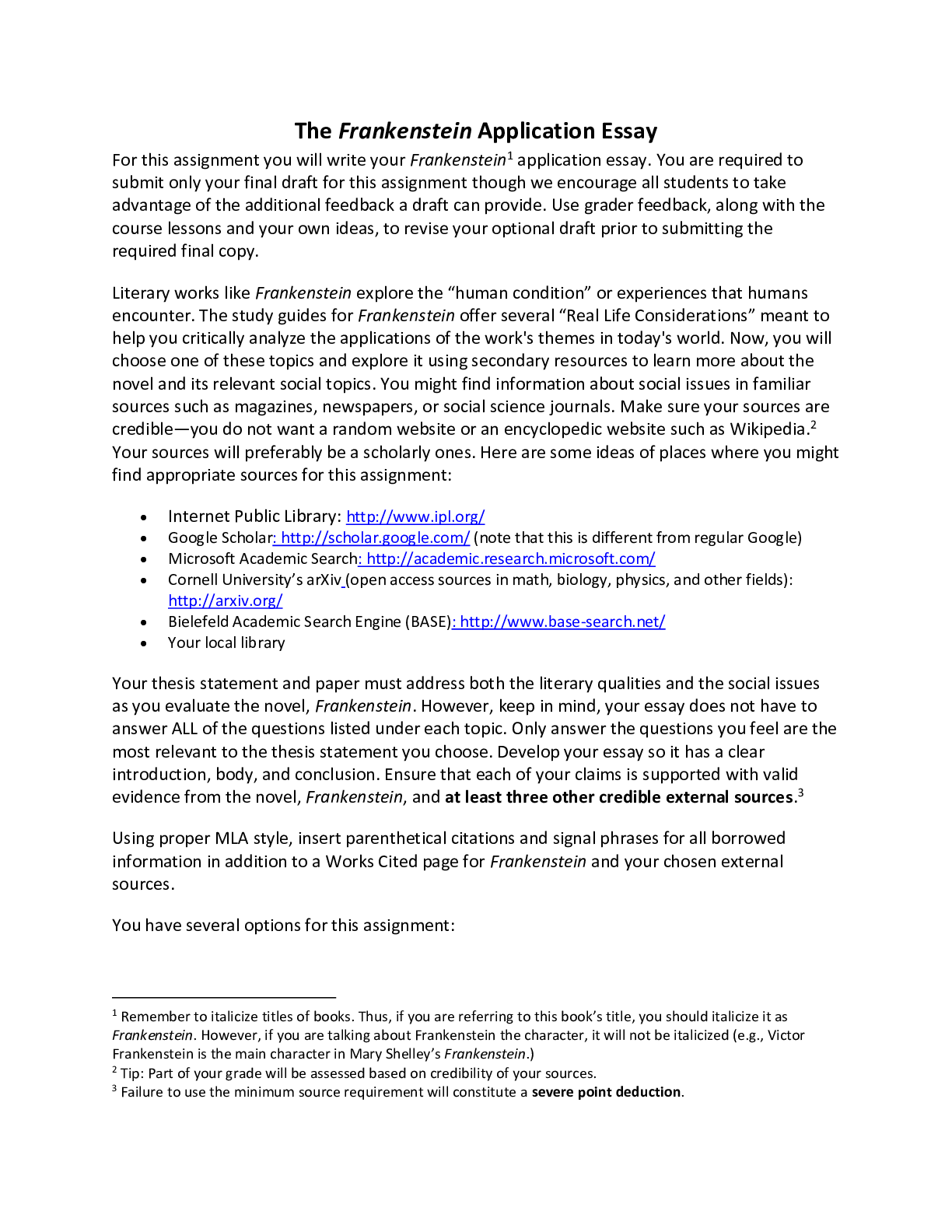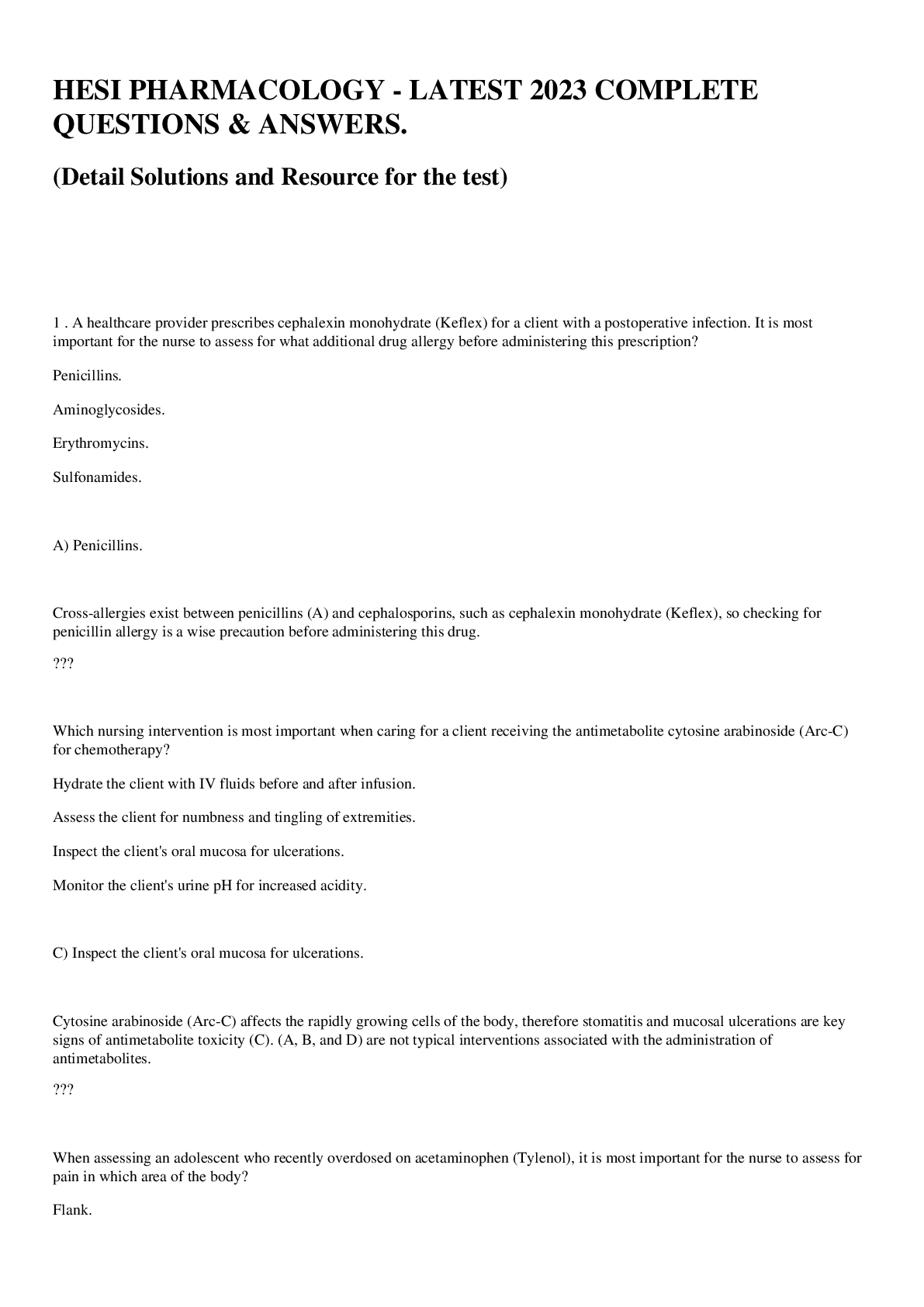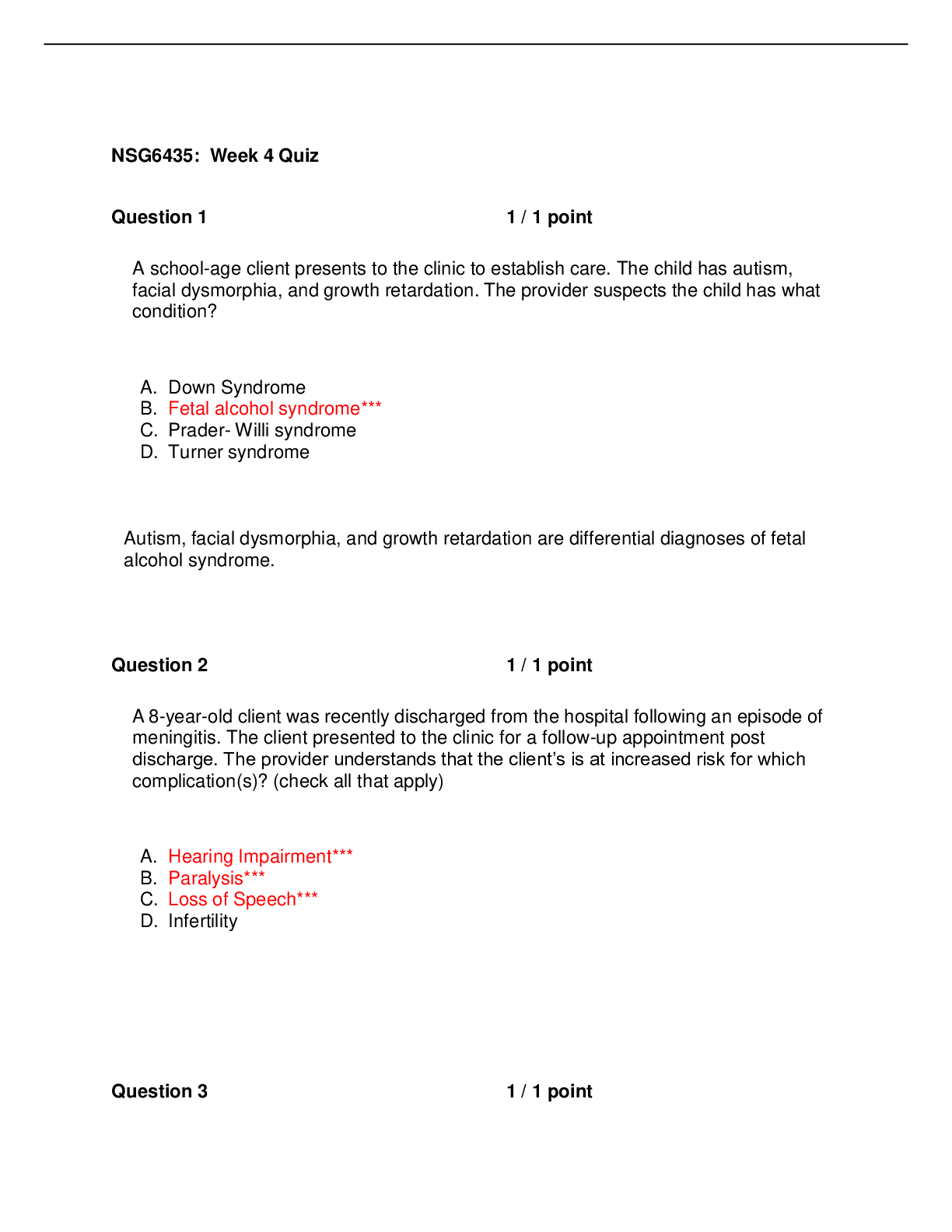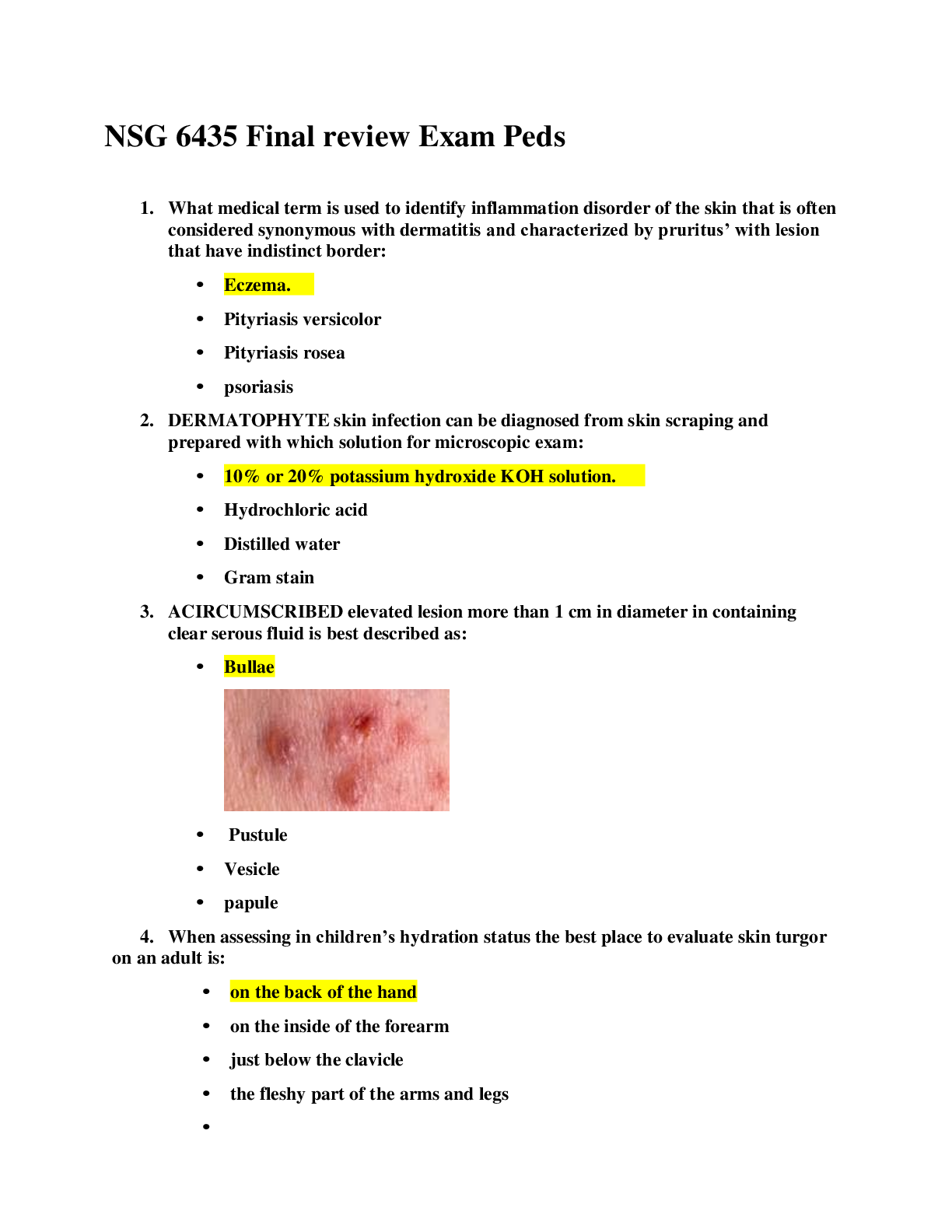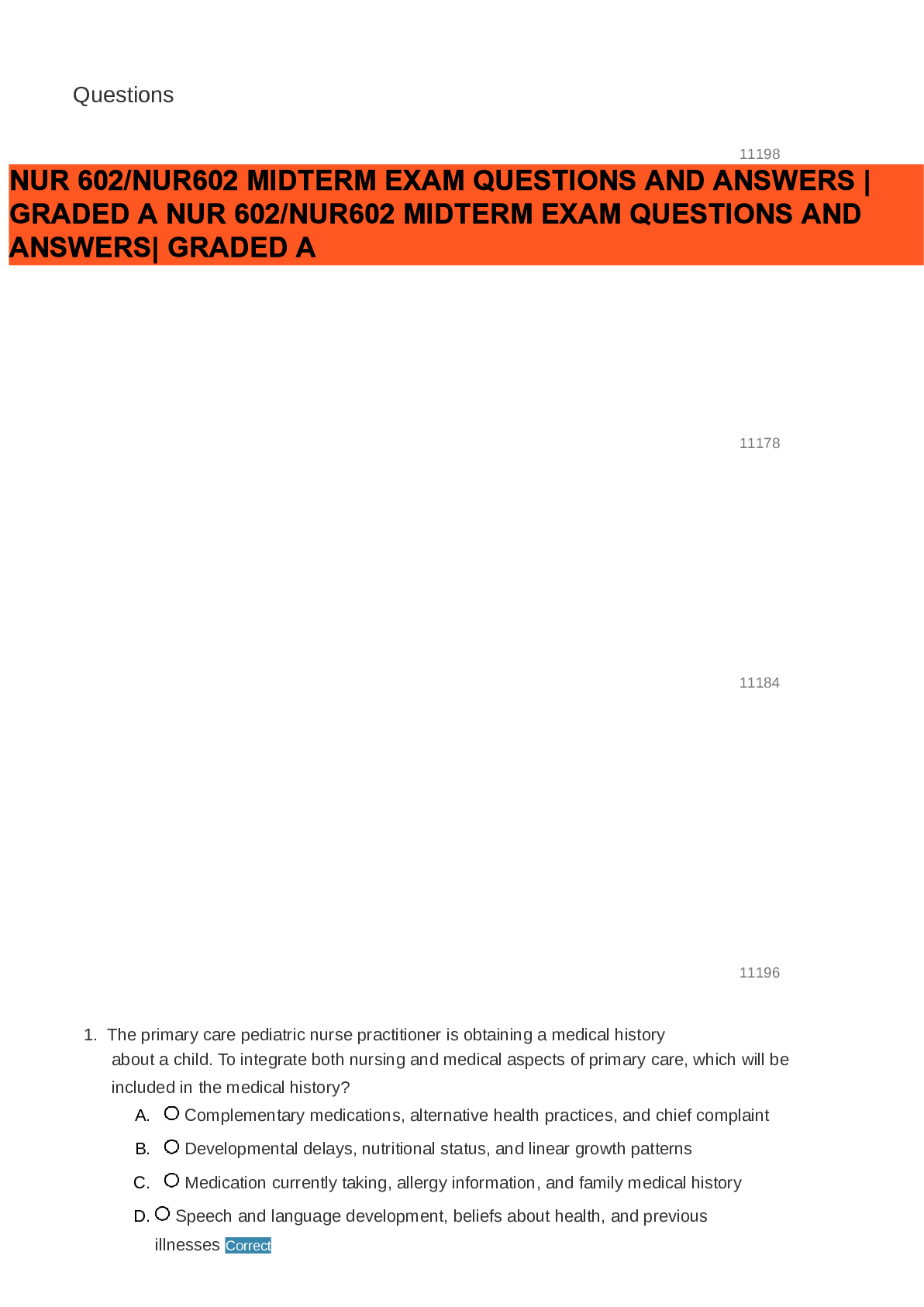Business > QUESTIONS & ANSWERS > Lakewood High School, Saint Petersburg - ECONOMICS 4211 (All)
Lakewood High School, Saint Petersburg - ECONOMICS 4211
Document Content and Description Below
ECONOMICS FOR THE VIRTUAL ENTERPRISE “The business of America is business.” —Calvin Coolidge Supply & Demand Activity Name: _____________________ Directions: Complete the questions below in ... RED text and insert shapes in the graphs OR complete the activities by hand then scan and upload the documents in this assignment box. Exercise 1: Create a supply schedule Your class has been asked to take part in a pilot program in which students are given the opportunity to work part time, before or after school, in the school library. Students hired can decide for themselves how many hours per week they will work, although no student can work more than 25 hours per week. The librarian is not sure how much money to offer (per hour) to attract enough students to meet the needs of the library so she asks your teacher to conduct a survey of the class by asking students to indicate the number of hours each would be willing to work at different hourly rates. Complete the table below by indicating how many hours you would be willing to work (assuming you would be hired) at the various rates the library is considering offering. Hourly rate # hours you would be willing to work $30 25 $25 20 $20 15 $15 10 $10 7 $7 5 $5 4 $3 0 $2 0 $1 0ECONOMICS FOR THE VIRTUAL ENTERPRISE “The business of America is business.” —Calvin Coolidge Exercise 2: Create a supply curve The survey to assess students’ willingness to work at the library was distributed to all seniors in the school; the total hours that students are willing to work at the different hourly rates are presented in the supply schedule for part time workers below: Supply Schedule for Part Time Workers Hourly rate # hours seniors are willing to work $30 1500 $25 1440 $20 1380 $15 1100 $10 840 $7 480 $5 240 $3 0 $2 0 $1 0 Using the data in the supply schedule for part time workers, draw the supply curve. Supply of Part Time Workers Hourly rate $30 $25 $20 $15 $10 $7 $5 $3 $0 200 400 600 800 1000 1200 1400 1600 1800 2000 2200 2400 2600 Quantity of Part Time Workers Supplied In your own words, summarize the information displayed in the graph. -As the amount paid by the hour, the more hours the seniors are willing to work so the hour’s increase.ECONOMICS FOR THE VIRTUAL ENTERPRISE “The business of America is business.” —Calvin Coolidge Exercise 3: Changes in Supply – A Shift in the Demand Curve The supply schedule below presents the results of a survey of seniors only, and seniors and juniors, indicating the number of hours these students would be willing to work in the school library at different hourly rates of pay. Supply Schedule of Student Workers’ Hours Hourly rate # hours juniors are willing to work (S1) # hours seniors are willing to work (S2) # hours juniors and seniors are willing to work (S3) $30 1125 1500 2625 $25 1080 1440 2520 $20 1035 1380 2415 $15 825 1100 1925 $10 630 840 1470 $7 360 480 840 $5 180 240 420 $3 0 0 0 $2 0 0 0 $1 0 0 0 Exercise 4: Using the data from the supply schedule for part time workers, draw supply curves S2 and S3 on the graph below. Supply of Part Time Workers 5 0 10 15 20 25 30 35 0 500 1000 1500 2000 2500 3000 Quantity of Part Time Hours Hourly Rates Refer to the chart you have drawn and answer the following questions:ECONOMICS FOR THE VIRTUAL ENTERPRISE “The business of America is business.” —Calvin Coolidge 1. When the hourly rate is $20, compare the quantity of hours’ students are willing to work at supply levels S1 and S2. Seniors are willing to work 345 hours more than the juniors. 2. When supply increases at all price levels, the supply curve shifts in which direction: right or left? Right 3. Explain the difference between an increase in supply and increase in the quantity supplied. It’s the increase in quantity when the demand and supply are at high rates and it’s an increase in supply when the demand is low and the supply rate is high. a. Which is depicted as a movement along the supply curve? 20hrs b. Which is depicted as a shift in the supply curve? 15hrs Exercise 5: In the table below, complete the following: 1. Record the affect on supply of each of the four determinants. 2. In each instance, state if the supply curve shifts right or left. 3. In your own words provide an explanation of the suppliers’ reactions. Determinant of supply Affect on supply Explanation A change in the price of inputs (raw materials, wages, etc.) A decrease in the price of inputs. Increase in supply the lower the price the more products will get bought An increase in the price of inputs. Decrease in supply The higher the price the less people will buy A change in the number of firms in the industry. Increase in the number of firms in the industry Increase of product the more firms there are then the more product gets produced Decrease in the number of firms Decrease in firms The less firms then the slower products gets produced. A change in taxes Increase in taxes The higher the price for supply Due to the products increase of demand Decrease in taxes The lower the supply price Due to the products decrease of demand Technology developmentECONOMICS FOR THE VIRTUAL ENTERPRISE “The business of America is business.” —Calvin CoolidgeECONOMICS FOR THE VIRTUAL ENTERPRISE “The business of America is business.” —Calvin Coolidge Imagine that you have opened a small business in your school selling Italian ices. You make the ices from fresh fruit – lemons, oranges, blueberries and cherries - using a family recipe that your grandfather has passed along. You are concerned about the price you pay for the fruit, as the price you pay for the ingredients is reflected in the price you charge your customers, and you are aware that there is a limit to what your customers are willing to pay. Although you would like to offer variety to your customers, if the price of any of the fruits becomes too high, you will cut back on your purchases, and offer less of that flavor to your customers. The quantity of lemons you are willing to purchase at various prices per bushel is presented in the table below. The lemon supplier obtains lemons directly from growers in Florida and has a variety of customers that include restaurants, supermarkets and fruit vendors. The quantity of lemons you are willing to purchase and the quantity of lemons the supplier is willing to offer at various prices per bushel are presented in the table below: Price per bushel Quantity demanded (D) Quantity supplied (S) $40 20 60 $32 30 50 $24 40 40 $16 50 30 $8 60 20 Exercise 6: For each price per bushel in the table: • Indicate whether there is a shortage (quantity demanded > quantity supplied) or a surplus (quantity supplied > quantity demanded) • Indicate the amount of the shortage or surplus. Price per bushel Quantity demanded (D) Quantity supplied (S) Surplus or shortage Amount $40 20 60 surplus 80 $32 30 50 surplus 80 $24 40 40 shortage 0 $16 50 30 shortage 20 $8 60 20 shortage 40 When a surplus exists: o Suppliers respond; the lemon supplier has unsold lemons that will soon go bad.ECONOMICS FOR THE VIRTUAL ENTERPRISE “The business of America is business.” —Calvin Coolidge 1. If the supplier is willing to offer lemons at a lower price, what happens to the quantity of lemons demanded? Quantity of the lemon demand will decrease 2. What happens to the size of the surplus as suppliers lower the price of lemons? The size of the surplus will increase When a shortage exists: o Suppliers respond; since the lemon supplier is able to sell all the lemons at the current price, this is a good opportunity to raise prices to increase profits. As long as the quantity demanded is greater than quantity supplied, suppliers can continue to raise prices. 1. What happens to the quantity of lemons demanded as suppliers raise the price? The quantity of the lemons will decrease due to the shortage 2. What happens to the size of the shortage when suppliers raise the price? The size of the shortage will become wider o Consumers respond; since at these prices the supply of lemons is less than demand, those who value the lemons the most are willing to pay more if they have to obtain lemons. Everyone does not value lemons equally. Consumers who value lemons the most will be willing to pay more. 1. What happens to the quantity of lemons demanded as the price increases? The quantity of lemons will increase 2. What happens to the size of the shortage as the price of lemons increases? The size of the shortage will decrease • At equilibrium (when there is neither a shortage nor a surplus): o Supply and demand is in balance, there is no pressure to change. 1. Can you explain why there is no pressure for the equilibrium price to change? As the customers pay more for the lemons he’s able to by exact amounts for lemons and other fruits 2. Can you think of events that would disturb this equilibrium? More customers lean towards the other fruits instead of the lemons.ECONOMICS FOR THE VIRTUAL ENTERPRISE “The business of America is business.” —Calvin Coolidge Exercise 7: Points A, B and C in the chart below depict either a shortage, a surplus or an equilibrium. Indicate what each letter represents in the chart by circling the correct term: A. Shortage, surplus, equilibrium point B. Shortage, surplus, equilibrium point C. Shortage, surplus, equilibrium point Lemon Supply & Demand 5 0 10 15 20 25 30 35 40 45 0 10 20 30 40 50 60 70 Bushels of Lemons Price per Bushel A B C [Show More]
Last updated: 2 years ago
Preview 1 out of 1 pages

Buy this document to get the full access instantly
Instant Download Access after purchase
Buy NowInstant download
We Accept:

Reviews( 0 )
$10.00
Can't find what you want? Try our AI powered Search
Document information
Connected school, study & course
About the document
Uploaded On
Feb 20, 2021
Number of pages
1
Written in
Additional information
This document has been written for:
Uploaded
Feb 20, 2021
Downloads
0
Views
65




